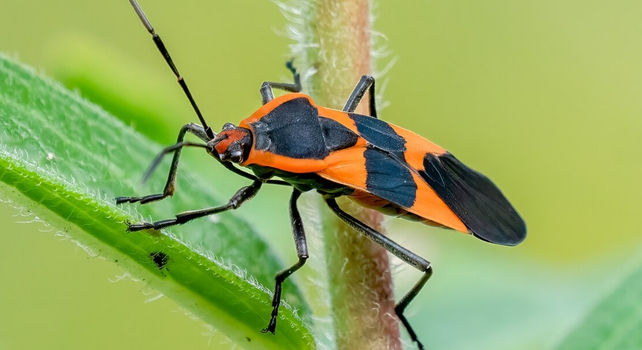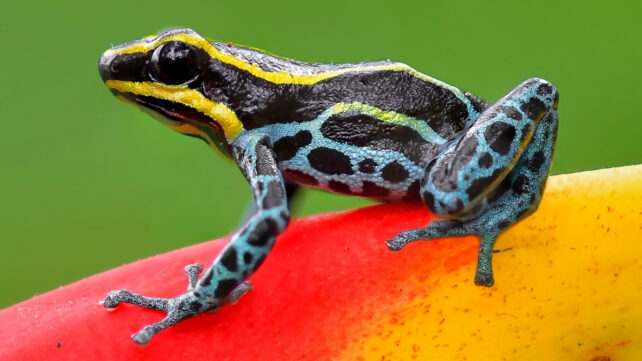The 10 snakes faced a tough predicament.
Collected from the Colombian Amazon, they had been without food for several days in captivity and then were presented with extremely unappetizing prey: three-striped poison dart frogs, Ameerega trivittata.
The skin of those frogs contains deadly toxins – such as histrionicotoxins, pumiliotoxins, and decahydroquinolines – that interfere with essential cell proteins.
Six of the royal ground snakes (Erythrolamprus reginae) preferred to go hungry. The other four intrepidly slithered in for the kill.
But before swallowing their meals, they dragged the frogs across the ground – akin to the way some birds rub toxins off their prey, noted biologist Valeria Ramírez Castañeda of the University of California, Berkeley, and her colleagues, who conducted the experiment.
Related: Slow-Motion Video Shows Snake Bites Like You've Never Seen Them Before
Three of the four snakes survived the meal – suggesting that their bodies were capable of handling the toxins that remained.

Living beings have been wielding deadly molecules to kill each other for hundreds of millions of years. First came microbes that used the chemicals to weed out competitors or attack host cells they were invading; then animals, to kill prey or ward off predators, and plants, to defend against herbivores.
In response, many animals have evolved ways to survive these toxins. They sometimes even store them to use against opponents.
Scientists are beginning to unravel these creative antitoxin defenses and hope as a result to identify better treatments for poisonings in people.
More fundamentally, they're learning about a force that has quietly helped to shape biological communities, says evolutionary biologist Rebecca Tarvin of UC Berkeley, who helped supervise the snake experiment and wrote about such strategies in the 2023 Annual Review of Ecology, Evolution, and Systematics.
"Just milligrams of a single compound, and that can change all of the interactions in an ecosystem," Tarvin says.
Biological warfare
Species become toxic in a variety of ways. Some of them make the toxins themselves: Bufonid toads, for instance, produce molecules called cardiac glycosides that stop a protein called the sodium-potassium pump from shunting ions in and out of cells. Such shunting is critical to maintaining cell volume, contracting muscles, and transmitting nerve impulses.
Other animals house toxin-producing bacteria in their bodies – that's the case for puffer fish, whose tetrodotoxin-containing flesh can prove lethal to consume.
And many others get their toxins through food – examples are poison frogs, which devour toxin-containing insects and mites; those frogs include the species that was fed to the ground snakes.
As some animals evolved to become toxic, they also rewired their bodies to avoid poisoning themselves. The same thing happened to creatures they eat, or that eat them.
The best studied of these adaptations involves changes to the proteins that are normally disabled by the toxins, so that they're now resistant. For example, insects that grow and feed on glycoside-rich milkweed plants have evolved sodium-potassium pumps that the glycoside cannot bind to.
But changing a vital molecule can create complications for a creature, says molecular biologist Susanne Dobler of Hamburg University in Germany. In her studies with the large milkweed bug, which feeds on milkweed seeds, she's found that the more glycoside-resistant the pump becomes, the less efficient it is. And that's a problem in nerve cells, where the pump is especially critical.
The bug seems to have evolved a way around the problem. In a 2023 study, Dobler and colleagues studied toxin resistance across three versions of the pump made by the creature.
They learned that the most functional one, in the brain, is also the most toxin-sensitive one. The milkweed bug must have evolved other ways to safeguard the brain from glycosides, Dobler says.

Dobler suspects that proteins called ABCB transporters are involved: These sit in cell membranes and shunt waste and other unwanted products out of cells. She has found that certain hawk moths use ABCB transporter proteins situated around their nerve tissues to shuttle cardiac glycosides out of cells. Maybe the milkweed bug is doing something similar.
Dobler is also testing a hypothesis that many insects have ABCB transporters in the membranes of their guts, stopping toxic substances from getting into the body to begin with.
That could explain how the bright red onion beetle, which feeds on glycoside-rich lily of the valley, is seemingly unfazed by the toxins and merely excretes them. The resulting feces have the benefit of repelling predatory ants, Dobler reported in 2023.
For the royal ground snakes, the liver seems to be key. From cell culture experiments, Tarvin's team has evidence that something in snake liver extract protects against toxins of three-striped poison dart frogs.
The team hypothesizes that the snakes have enzymes that convert the deadly substances into nontoxic forms, much as human bodies do with alcohol and nicotine. Snake liver may also contain proteins that stick to toxins and render them unable to bind to their targets – mopping them up like sponges.

Scientists have discovered such "toxin sponge" proteins in the blood of some poison frogs, enabling them to resist the deadly saxitoxin and alkaloid toxins they get from their diet.
California ground squirrels seem to use a similar trick to defend themselves against rattlesnake venom, a cocktail of dozens of toxins that destroy blood vessel walls, prevent blood from clotting, and more. Ground squirrel blood contains proteins that block some of these toxins – like the proteins rattlers use themselves for protection should venom escape their specialized venom glands.
The composition of venom differs across snake populations, and evolutionary biologist Matthew Holding of the University of Michigan has evidence that the ground squirrels' antivenom mix is tailored to match local snakes.
Such defenses aren't bulletproof. Rattlesnakes are constantly evolving new venom to overcome the squirrels' defenses, Holding says, and even a rattler will die if injected with enough of its own venom.
That's why animals, even resistant ones, try, as a first defensive step, to avoid toxins. Hence the dragging behavior of ground snakes, and the practice of some turtles to consume only the belly skin and innards of toxic newts, not the deadly back skin.
Even insects like monarch caterpillars that are resistant to cardiac glycosides will nick the veins of milkweed plants to drain out the toxic fluid before tucking into the plant.
Co-opting toxins
Many animals also find ways to safely store toxic chemicals they consume and use them for their own purposes. The iridescent dogbane beetle, for example, gets cardiac glycosides from its host plants and then – probably via ABCB transporters – shuttles them onto its back for self-defense.
"When you somehow annoy these beetles, you can see little droplets appear on their elytra, their dorsal surface," Dobler says.
Through this kind of poison coopting, some insects become dependent on their host plants for survival. The relationship between the monarch butterfly and the milkweed plant is a prime example – and a prime example, too, of the long reach that such intertwined connections may have.
In a 2021 study, evolutionary biologist and geneticist Noah Whiteman of UC Berkeley and his colleague identified four animals that have evolved to tolerate cardiac glycosides, allowing them to feed on monarchs. One is the black-headed grosbeak, a bird that feasts on monarchs in Mexico's mountaintop fir forests where the butterflies fly south to overwinter.
Think of it, Whiteman says: A toxin that was assembled in a milkweed plant on an Ontario prairie has helped to shape the biology of a bird so that it may safely dine in a forest thousands of miles away.
"It's just amazing," he says – "the journey traveled by this small molecule, and the influence that it has on evolution."
This article originally appeared in Knowable Magazine, a nonprofit publication dedicated to making scientific knowledge accessible to all. Sign up for Knowable Magazine's newsletter.
